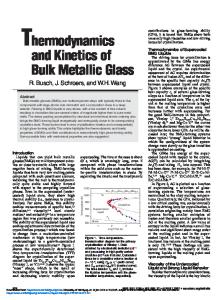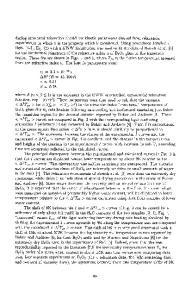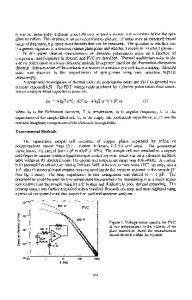The Thermodynamics of the Glass Transition
- PDF / 601,984 Bytes
- 11 Pages / 420.48 x 639 pts Page_size
- 39 Downloads / 394 Views
3
THE THERMODYNAMICS OF THE GLASS TRANSITION MATS HILLERT Div. of Physical Metallurgy,
Royal
Inst. Techn.
S-l00 44 Stockholm, Sweden
ABSTRACT The kinetic theory of the glass transition is examined. Some modifications are suggested in order to overcome some shortcomings. As a result, a thermodynamic description of the glass transition is obtained. It is demonstrated that the glass transition represents the beginning of a very gradual process of melting in the amorphous state. INTRODUCTION For many years there have been two divergent opinions concerning the origin of the glass transition which is defined by a large change in the mechanical properties of an amorphous phase. One opinion is that it is essentially a thermodynamic phase transition. The other opinion is that it is rather an apparent transition caused by a rapid change in the relaxation time for various processes in the amorphous state. Today it seems to be generally agreed that the glass transition, as observed experimentally, is a purely kinetic phenomenon (1). At the same time it is realized that infinitely slow cooling should produce an ideal glass structure at a temperature below the mechanical glass transition if crystallization could be avoided (2). The thermodynamic properties of this ideal glass structure are supposed to be similar to those of the crystalline state (3). There should thus be a dramatic change in thermodynamic properties of the amorphous phase at some temperature T below that of the mechanical glass transition, Tg. We may call T the ideal ?hermodynamic glass transition. According to the prevailing opinion, the practical thermodynamic glass transition is displaced to coincide with the mechanical one due to kinetic reasons, the idea being that the structure can no longer change when the amorphous phase has hardened by going through the mechanical glass transition. The non-ideal glass structure is thus frozen in and, when the structure can no longer change with temperature, the thermodynamic properties will be very similar to those of the ideal glass, which by definition has no structural changes. On the other hand, there is also a coupling to the mechanical glass transition because the mechanical properties depend upon the structure of the amorphous state. The material is more solid, the closer the structure is to the ideal glass structure. It thus seems difficult to avoid the surprising conclusion that an increase of the cooling rate will displace the mechanical glass transition to a lower temperature but the thermodynamic one to a higher temperature. In recent years the interest seems to have been centered around the kinetic aspects. The purpose of the present work was to examine the thermodynamic aspects. However, it is adequate to start by considering the kinetic aspects. THE NATURE OF THE KINETIC THEORIES From a practical point of view, the glass transition is the process in the amorphous state by which the viscosity of a liquid increases continuously to very high values. This transition occurs on cooling in a rather narrow r
Data Loading...










